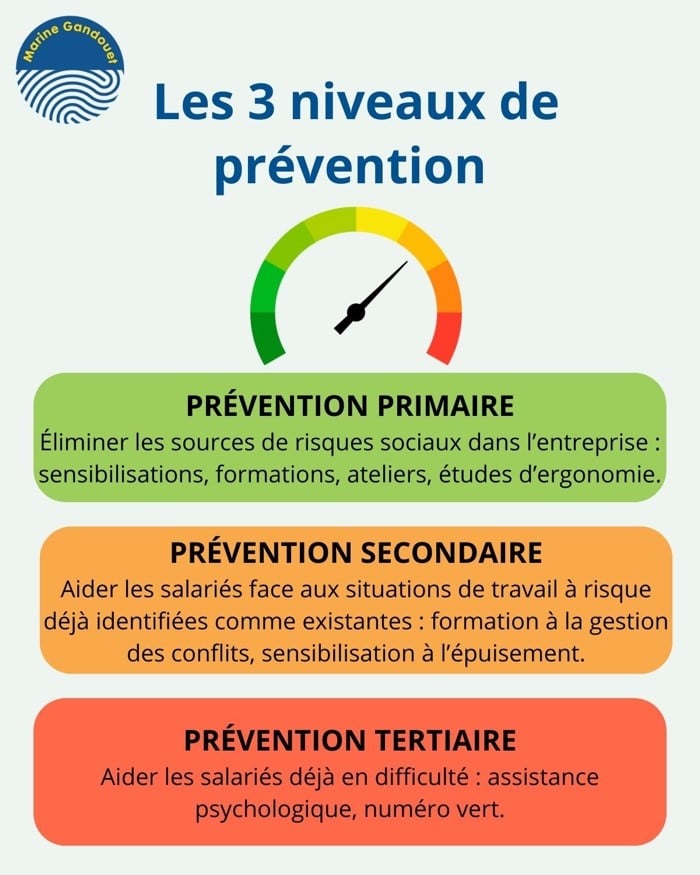Burn-out is a major cause for concern. Marine Gandouet, coach and trainer, explains how to better understand, detect and avoid it.

According to the 14th "Psychological health of French employees" barometer conducted by OpinionWay for Empreinte Humaine, 31 % of employees will be at risk of burn-out in 2025, including 10 % at a severe level (sick leave with risk of hospitalisation and need for psychological support). This represents around 2.5 million people.
Stress at work was also the leading cause of sick leave in France in 2022.
That's why HR plays a key role This is a key factor in preventing burnout and safeguarding the health of employees and the company.
Understanding burnout
Definition of burn-out
The World Health Organisation (WHO) defines burn-out as a syndrome resulting from chronic occupational stress that has not been successfully managed.
It is characterised by three dimensions:
- a feeling of loss of energy or exhaustion
- increasing distance from work, negative emotions or cynicism about one's job
- reduced professional effectiveness
Burn-out means to burn until all energy is gone. In other words, it's the act of being completely consumed. In other words, a burned-out person is drained of energy, feels physically, psychologically and emotionally exhausted, and develops a feeling of self-depreciation. This exhaustion originates in the workplace. It develops insidiously, over time.
This is an imbalance between energy expenditure and energy resources/gains. The problem is not the expenditure of energy but the fact of spending more energy than its capacity to regenerate.
For example, if a mobile phone is used all day long, it will run down to the point where it has no battery. If it is not recharged, it cannot be used again. Recharging is essential. It's the same for humans. By way of regeneration, it needs time to rest in order to regain its equilibrium and cope with its energy expenditure.
Causes of burnout and risk factors
While the main sources of burnout are to be found in the world of work and the relationship between the individual and his or her work, many other factors also come into play.
In her book Guide du burn-out, comment l'éviter, comment s'en sortir, author Anne Everard takes stock of the various causes of burn-out. Here's a mind map summarising the essentials.

Some people therefore have a high-risk profile, often with the same type of characteristics.
They are :
- motivated
- very committed to their work
- perfectionists
- reliable
- more attentive to the needs of others than to their own needs
What's more, they require very little help.
The strategic role of HR in prevention
The prevention of psychosocial risks (RPS) is a challenge for all those involved in the world of work. In addition to the regulatory obligations imposed on employers, preventive measures are invaluable for companies in preserving human capital and ensuring that strategic and operational objectives are met.
Identifying the warning signs of burnout
Firstly, it is essential to be able to detect the risk by spotting the warning signs of employee burnout. HR must therefore support managers in developing their observation and questioning skills.
1/ Individual warning signs
Here is a list of questions linked to warning signals that you can pass on to managers for a 1st level of prevention.
Chronic fatigue/lack of energy
Does the employee complain that he or she lacks the energy to do the job?
Are they still tired after rest periods (weekends, holidays, etc.)?
Sleep disorders
Does he have trouble falling asleep at night?
Do you find yourself ruminating or waking up at night?
Loss of joy/unpleasant emotions
Do you have any feedback on the loss of joy?
Or a progression of unpleasant emotions such as fear, anger or sadness?
Are employees easily irritated?
Cognitive problems
Does he have difficulty concentrating or memorising, which was not the case before?
Physical pain
Do they complain of physical aches and pains such as headaches, backaches or stomach aches, or tension that recurs over time?
Social isolation
Have you noticed any withdrawal?
For example: no lunchtime get-togethers with colleagues, fewer off-duty discussions between colleagues, more teleworking, etc.
Reduced motivation
Are they showing unusual signs of professional disengagement/disinvestment?
These warning indicators can be used to place the employee on a burnout scale.
Managers can then offer employees additional tests, such as the MBI (Maslach Burnout Inventory) or the CBI (Copenhagen Burnout Inventory). The aim is to raise employees' awareness, without asking them for their own results.
2/ Warning signs at company level
At company level, other indicators are markers of the progression of burnout.
For example:
- Increased absenteeism: late arrivals, absences
- Growth in the number of work stoppages
- Reduced productivity
- Deterioration in working conditions: accidents in the workplace
- Impact on interpersonal relations: team tensions, demotivation, etc.
Beyond the human aspect, the consequences for the company include :
Economic, with the costs and losses associated with work stoppages
- Loss of sales
- Higher workload for other employees
- Possible training costs related to replacements
In terms of image
- A less attractive employer brand.
- The brand image is weakened.
[Training]
Psychosocial risks: implementing a preventive approach
3 key points:
- understanding the issues surrounding psychosocial risks (PSR)
- identify the main factors
- implement a preventive approach to stress, burn-out, moral harassment and suffering at work within your company
Examples of practical exercises :
- practical case studies
- role-playing games
- brainstorming
- self-diagnosis of management practices
They're talking about :
"An enriching and comprehensive course, even at a distance! The content is structured and provides a comprehensive understanding of PSR. The discussions are rich and complement the theory well. The trainer is a great teacher and provides invaluable tools!
[Also read]
Psychosocial risks: from prevention to training
By taking ownership of this issue, companies can not only meet the expectations of their teams, but also build a sustainable and satisfying working environment. But how do you go about it?
Prevention, an HR policy within a legal and regulatory framework
Employers' obligations to protect employees' mental health
Under the Labour Code, employers are required to take the necessary measures to protect the physical and mental health of their employees. These measures include, in particular, measures to prevent occupational risks (art. L 4121-1). Another obligation is to assess the risks to workers' health (art. L 4121-3). It must also transcribe and update the results of this assessment in a single document (art. R. 4121-1). This is known as the DUERP or document unique d'évaluation des risques professionnels.
What is prevention?
Prevention is the implementation of a set of actions to avert a risk. In this case, we are talking about preventing the risk of depleting vital energy, a resource that is running out.

Prevention means: observing to spot the risk, measuring to alert, acting to stop and regain balance.
There are 3 levels of prevention: primary, secondary and tertiary.
PRIMARY: absence of signs of exhaustion, state of equilibrium.
SECONDARY: detection of early signs, onset of imbalance.
TERTIARY: presence of advanced signs of exhaustion, dysfunction and pathologies.
Specific actions can be calibrated for each level.
Example of actions to be implemented by HR
Primary prevention: information, awareness-raising, training
The company can initiate a number of primary prevention actions when no signals are detected. This is ideal for acquiring and developing skills that maintain a state of equilibrium.
Numerous formats can be offered on the subject of burnout and stress management, both for employees and for local managers:
- Newsletters
- Conferences
- Raising awareness
- Workshops
- Training
For example:
Train your staff
ORSYS training Managing stress provides practical tools for dealing effectively with pressure and other stress factors. Thanks to a balanced approach between theory and practice, employees learn to identify their sources of stress, analyse their effects on their performance and well-being, and develop strategies to minimise their impact.
Examples of practical exercises: self-diagnosis, brainstorming, breathing and relaxation techniques, drawing up an individual action plan.
In their own words: "The training is focused on people and not just on theory. The discussions add a lot to the training.
Keep your staff informed
Examples of newsletter resources:
The article Communicating better to prevent burn-out shows how optimising your communication with yourself can optimise your communication with others. It is based on the example of Emma, a manager in a personal services company.
In the article Burn-out: managerial action at the heart of preventionThe situation of Jeanne, an educational assistant in a specialised home, illustrates the role of managers in preventing burn-out.
Finally, article How do you manage without burning out? looks at solutions to combat manager burnout.
The more operational these formats are, the more effective prevention is. In fact, being able to identify the warning signs of exhaustion and put in place a routine to regenerate helps each employee to protect themselves in the face of stressful, energy-intensive situations.
Secondary prevention: setting up an organisation and appropriate resources
If the first individual warning signs are already present, secondary prevention measures need to be implemented immediately. This involves :
1/ first of all, listening
2/ actions to be adapted on a case-by-case basis
For example:
- make an appointment with occupational medicine
- offer training or individual support on burnout
- reorganising working hours (offering part-time work or teleworking)
- supporting the return to work after a long period off (systematically offering a return interview)
Testimonial
Paul, HR Manager
When project manager Sophie returned to work after a burn-out, we offered her part-time work. This transition enabled her to gradually find her own rhythm, without pressure, while maintaining her motivation. Her manager was able to organise the distribution of tasks more effectively, while the team became more cohesive as it adapted its working methods. As an SME, we have every interest in adapting our working methods. Supporting our employees in difficult times strengthens their commitment and loyalty.
What can be done if burnout is denied?
A phase of denial may be present. Denial is a mechanism that is unique to each person, and its positive intention is to protect oneself.
Here's a good practice to communicate to managers: keep it factual. In other words, rely on concrete observations.
For example:
- Lucie, I've noticed that for the last month you haven't been having lunch with your colleagues.
- I've also noticed that you take your phone to consult it at every meeting, which wasn't the case before.
- Over the last 6 months, I've noticed that your posture has changed. You massage your shoulders and neck several times an hour.
- I'm worried because I can see that these changes are causing physical tension, difficulty concentrating and isolation. How are you getting on?
Despite this, the manager must bear in mind that acceptance can take months. The best reflexes are to keep listening, sharing factual observations and regularly asking "How are you feeling at the moment?
Structure the prevention approach in 4 stages
Finally, to be effective, it is essential to structuring a concrete approach prevention of psychosocial risks.
4 stages:
1/ Assess RPS (using questionnaires, for example)
2/ Identifying levers for action and drawing up a prevention plan
3/ Setting up a monitoring system
4/ Responding to deteriorating situations
Ultimately, burnout is present in all companies. It is insidious and takes hold over time. Prevention by the company and HR is essential. It's a question of observing to spot the risk, measuring to alert, acting to stop and regain balance. The more concrete action is taken before any signs of burnout appear, the more likely it is to be limited. The benefits will be felt as much for the health of the employees as for that of the company.
Bibliography - Additional resources for further reading:
- Guide to psychosocial risks in the workplace - Caroline Moyat-Ayçoberry (Gereso, 2023, 7th edition)
- Prévenir les RPS et améliorer la QVCT : des outils pour agir efficacement - Élodie Montreuil (Dunod, 2023, 5th edition)
- Le Burn-out, comment le prévenir ou en sortir? - Barbara Delbrouck (De Boeck Superieur, 2022, 1st edition)







